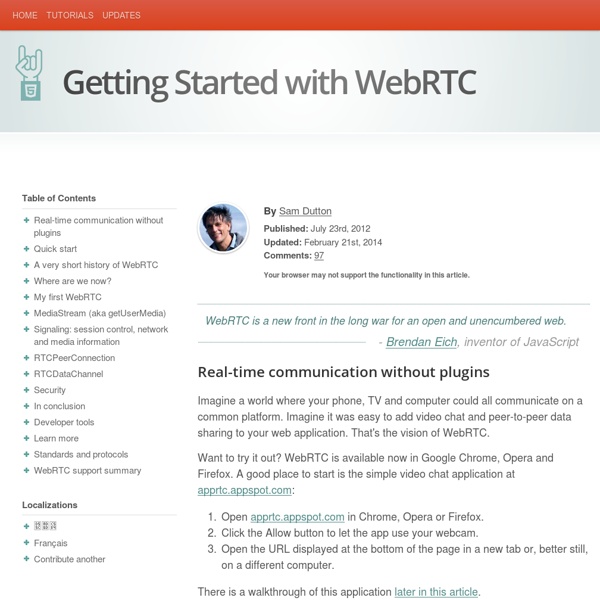Getting Started with WebRTC

http://www.html5rocks.com/en/tutorials/webrtc/basics/
Related: javascript
Infographic: The Entire JavaScript Language in One Single Image
Chinese-based developer Yusheng, has created a nice graphic that assembles the entire JavaScript programming syntax into one single all-encompassing image. Regardless of what the TIOBE Index says, JavaScript, and not Java, is the hottest programming language right now. This popularity was won very hard, having to fight through a period where the language seemed to have stood still with no new features being released for a period of four years.
11 Free jQuery CSS3 Navigation Menu Plugins
These days, jQuery Navigation menus are more than plain texts with links on it. With the command of jQuery, it can transform the menu of a web site into a dynamic menu. Despite the fact that CSS3 can now be utilized to make dynamic menu, still, the query includes more functionality to the menus. Aside from the element functionalities, the design should likewise be considered. Because of audience your site would perhaps see it for the first time they visit your website. If it is not well designed any having worst UI experience so it will not give you value add to your site.
Getting Started Guide
NativeScript Getting Started Guide Welcome to the NativeScript Getting Started Guide. In this tutorial you'll use NativeScript, a cross-platform JavaScript framework for building native mobile apps, to build an iOS and Android app from scratch.
Recline.js - Recline Data Explorer and Library
A simple but powerful library for building data applications in pure Javascript and HTML. Features: Open-source (and heavy reuser of existing open-source libraries)Pure javascript (no Flash) and designed for integration — so it is easy to embed in other sites and applicationsView and edit your data in clean grid interfaceBulk update/clean your data using an easy scripting UIVisualize your dataAnd more …
Coder's Block Blog / Motion Detection with JavaScript
I recently gave a talk at RevolutionConf about writing a motion detecting web app with JavaScript. This is basically that talk, but in blog form. Live demos and all the source code are available at the end of this article.
Bubble Sort Algorithm in JavaScript
This is a follow up to Big O Search Algorithm Examples in JavaScript. The JavaScript examples in the post all made the same assumption, that the list was already sorted. So, how do we sort? The Theory
Beginner's Guide to HTML5 & CSS3 - Coding Canvas
Download html5canvas.zip - 5.5 KB Introduction Traditional HTML was created with text in mind. While the insertion of images can be done through the <img> tag, the inclusion of animation will require third-party plug-ins. In this respect, traditional HTML is vastly lacking in its capability to meet the multimedia needs of modern web pages. Fret not!
CRUD operation using Backbone.js
Download UserManagement.zip - 5.2 MB Introduction Learning backbone.js for basic create, read, update and delete operations.
OOP In JavaScript: What You NEED to Know
(Object Oriented JavaScript: Only Two Techniques Matter) Prerequisite:JavaScript Objects in DetailJavaScript Prototype Object Oriented Programming (OOP) refers to using self-contained pieces of code to develop applications. We call these self-contained pieces of code objects, better known as Classes in most OOP programming languages and Functions in JavaScript. We use objects as building blocks for our applications. Building applications with objects allows us to adopt some valuable techniques, namely, Inheritance (objects can inherit features from other objects), Polymorphism (objects can share the same interface—how they are accessed and used—while their underlying implementation of the interface may differ), and Encapsulation (each object is responsible for specific tasks).
Classical Inheritance in JavaScript
Douglas Crockford www.crockford.com And you think you're so clever and classless and free — John Lennon JavaScript is a class-free, object-oriented language, and as such, it uses prototypal inheritance instead of classical inheritance. This can be puzzling to programmers trained in conventional object-oriented languages like C++ and Java.
javascript-society/javascript-path
Voxel Builder
Related:


